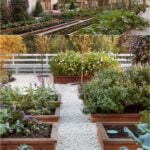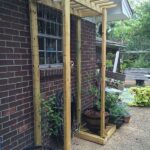Are you looking to spruce up your outdoor space with some simple DIY landscaping ideas? Whether you have a spacious backyard or a small balcony, there are plenty of ways to enhance your surroundings without breaking the bank. In this article, we will explore the beauty of DIY landscaping and provide you with easy-to-follow tips and tricks for creating a stunning outdoor oasis.
Before diving into specific design ideas, it is essential to first assess your space. Understanding the layout and size of your outdoor area will help determine what landscaping elements will work best for you. From there, selecting the right plants is crucial in achieving a low-maintenance garden that thrives with ease. We’ll guide you through choosing easy-to-grow options that will flourish in your specific environment.
Once the greenery is sorted out, we’ll move onto creating a relaxing seating area where you can unwind and enjoy the fruits of your labor. And what’s an outdoor space without decorative touches? We’ll show you how to incorporate garden ornaments, lighting, and other enhancements to elevate the aesthetic appeal of your landscape. So let’s roll up our sleeves and get ready to transform your outdoor space with these simple DIY landscaping ideas.
Assessing Your Space
When it comes to embarking on your DIY landscaping journey, the first step is to assess the layout and size of your outdoor space. Whether you have a small backyard or a spacious garden, understanding the dimensions and natural elements of your area will help guide your landscaping decisions. Here are some key factors to consider:
1. Measure the dimensions: Start by measuring the length and width of your outdoor space. This will give you a clear idea of how much room you have to work with and where you can place different landscaping features such as garden beds, seating areas, or pathways.
2. Take note of sun exposure: Observe how the sunlight moves across your outdoor area throughout the day. This will help you determine which areas receive full sun, partial sun, or shade. Understanding sun exposure will guide your plant selection and placement.
3. Consider existing elements: Take note of any existing features in your outdoor space such as trees, shrubs, or structures like fences or patios. These elements can help define different zones within your landscape and influence design choices for creating a cohesive look.
With these key factors in mind, assessing your space will provide a solid foundation for planning and implementing simple DIY landscaping ideas tailored to the unique characteristics of your outdoor area. By understanding the layout and size of your space, you can make informed decisions that enhance the beauty and functionality of your landscape while staying within budget constraints.
Selecting the Right Plants
When it comes to DIY landscaping, choosing the right plants is crucial for creating a low-maintenance, easy-to-grow garden. Whether you have a green thumb or are new to gardening, selecting the right plants can make all the difference.
One simple DIY landscaping idea is to opt for native plants that are well-suited to your specific climate and soil conditions. These types of plants are generally easier to care for and require less maintenance in terms of watering and fertilizing.
Another great option for a no-fuss garden is to choose perennial plants, which come back year after year without needing to be replanted. Perennials also tend to require less water and care compared to annuals, making them a practical choice for a low-maintenance garden. Some popular choices for perennials include lavender, coneflowers, and daylilies, all of which add beauty and color to your outdoor space with minimal effort.
In addition, incorporating edible plants into your landscape can serve a dual purpose by providing fresh fruits, vegetables, or herbs while adding visual interest. Easy-to-grow options like cherry tomatoes, strawberry plants, and basil not only require less upkeep but also add functionality to your garden.
When choosing plants for your outdoor area, it’s important to consider factors such as sunlight exposure, water requirements, and the overall aesthetic you want to achieve. By carefully selecting low-maintenance options that thrive in your specific environment, you can create a beautiful garden with minimal effort.
| Low-Maintenance Plant Options | Benefits |
|---|---|
| Native Plants | Well-suited to specific climate and soil conditions |
| Perennials | Come back year after year without needing replanting; require less water and care than annuals |
| Edible Plants | Add functionality while requiring minimal upkeep; provide fresh fruits, vegetables, or herbs |
Creating a Relaxing Seating Area
Designing a cozy and inviting seating area in your outdoor space can transform it into a relaxing oasis. Whether you have a large backyard or a small patio, there are simple DIY landscaping ideas that can help you create the perfect spot for lounging and entertaining. Here are some tips for designing a comfortable seating area:
- Choose the right furniture: Select comfortable and durable outdoor furniture such as weather-resistant chairs, sofas, or benches. Opt for easy-to-clean materials like polyethylene wicker or powder-coated aluminum to ensure longevity.
- Add soft furnishings: Enhance the comfort of your seating area by incorporating outdoor cushions, pillows, and throws in coordinating colors or patterns. Look for fabrics made with UV-resistant and water-repellent properties to withstand the elements.
- Create shade: Consider adding an umbrella, pergola, or canopy to provide shade and protect against harsh sunlight. This will make your seating area more pleasant and usable during hot summer days.
- Incorporate greenery: Use potted plants, hanging baskets, or vertical gardens to add natural elements to your seating area. Choose low-maintenance plants such as succulents, herbs, or ornamental grasses that can thrive with minimal care.
By following these simple DIY landscaping ideas, you can create a cozy and inviting seating area that complements your outdoor space and encourages relaxation and enjoyment. Whether you’re looking to entertain guests or simply unwind after a long day, a well-designed seating area can become the focal point of your backyard or patio.
Adding Decorative Touches
When it comes to enhancing the beauty of your outdoor space, garden ornaments, lighting, and other decorative touches can make a big impact. One simple DIY landscaping idea is to incorporate decorative elements that reflect your personal style and create visual interest in your garden. Whether you prefer whimsical garden gnomes or elegant stone statues, there are countless options to choose from to add character to your landscape.
In addition to garden ornaments, strategic outdoor lighting can transform your garden into a magical oasis after dark. Solar-powered lights are an eco-friendly option for illuminating walkways and highlighting key focal points in your garden. String lights can also create a warm and inviting ambiance for evening gatherings and al fresco dining. When selecting lighting options for your outdoor space, consider both aesthetic appeal and functionality.
To further enhance the overall look of your garden, consider other simple enhancements such as creating a small water feature, installing a trellis or arbor for climbing plants, or adding colorful ceramic pots filled with blooming flowers. These small details can elevate the design of your landscape while adding charm and personality to your outdoor oasis. By incorporating carefully selected decorative touches, you can turn your backyard into a tranquil retreat that is both visually stunning and welcoming for relaxation.
| Landscaping Enhancement | Description |
|---|---|
| Garden Ornaments | Incorporate unique and eye-catching ornaments such as sculptures or wind chimes. |
| Outdoor Lighting | Add solar-powered lights or string lights to create ambiance and highlight key features. |
| Additional Enhancements | Consider water features, trellises, arbors, or colorful planters to elevate the overall look of your garden. |
Building a Simple Pathway
Creating a charming pathway in your yard can instantly enhance the visual appeal of your outdoor space. Whether you have a small garden or a spacious backyard, a simple DIY pathway can add character and functionality to your landscape. When it comes to designing a walkway, there are various materials and styles to choose from, making it an enjoyable and creative project for any homeowner.
Start by assessing the layout and size of your outdoor area to determine the best location for your pathway. Consider factors such as foot traffic patterns, sunlight exposure, and any existing landscaping features. Once you’ve identified the ideal spot for your walkway, it’s time to select the right materials.
From gravel and stepping stones to brick pavers and concrete tiles, there are countless options available for creating a durable and visually appealing pathway. Choose materials that complement the style of your home and garden while also considering practicality and ease of installation.
When building a DIY pathway, it’s essential to plan the design and layout before getting started. Use stakes and string to outline the desired shape of your walkway, ensuring smooth curves or straight lines depending on your preference.
Consider adding edging materials such as border stones or metal strips to define the edges of the pathway and prevent encroachment from grass or garden beds. With careful planning and attention to detail, you can create a charming walkway that enhances the overall aesthetics of your outdoor space while providing functional access throughout your garden.
Incorporating lighting along the pathway can also enhance its visual appeal while increasing safety during evening hours. Solar-powered lanterns, low-voltage LED lights, or strategically placed spotlights can illuminate the walkway and highlight nearby landscaping features. Adding decorative touches such as planters, ornamental rocks, or edging plants can further enhance the charm of your DIY pathway, creating an inviting atmosphere for both residents and visitors alike.
DIY Garden Beds
If you’re looking to add some greenery to your outdoor space, creating DIY garden beds is a fantastic way to do so. Whether you have limited space or a sprawling yard, garden beds can be customized to fit your needs and aesthetic preferences. With some simple DIY landscaping ideas, you can design and build raised or container garden beds that will enhance the beauty of your outdoor area.
Assessing Your Space
Before diving into the creation of garden beds, it’s important to assess your outdoor space. Take note of the layout, size, and sunlight exposure in different areas of your yard. This will help you determine the best location for your garden beds and which plants will thrive in those spots.
Choosing the Right Materials
When it comes to building raised garden beds, there are various materials you can use, such as wood, concrete blocks, or even recycled materials like old tires or pallets. For container garden beds, consider using decorative pots or planters that complement the style of your outdoor space. Whichever materials you choose, make sure they are sturdy and suitable for withstanding outdoor conditions.
Selecting Plants for Your Garden Beds
Once you have decided on the type and location of your garden beds, it’s time to select the right plants. Opt for low-maintenance options that are easy to grow and maintain. Consider factors such as sunlight requirements, water needs, and the overall look you want to achieve in your garden beds. With some thoughtful planning and consideration, you can create a stunning display of flowers, herbs, or vegetables in your DIY garden beds.
Maintaining Your Landscape
Regular Maintenance
Once you have completed the initial landscaping tasks, it is essential to keep up with regular maintenance to ensure that your garden continues to look its best. This includes tasks such as weeding, mowing the lawn, trimming bushes and hedges, and keeping pathways clear. Set aside dedicated time each week for these maintenance tasks to prevent your outdoor space from becoming overgrown or unkempt.
Watering Techniques
Proper watering is crucial for the health of your plants and flowers. The frequency and amount of water needed can vary depending on the specific needs of each plant species. Consider installing a simple drip irrigation system or soaker hoses to ensure that your plants receive consistent moisture without excessive water waste. Additionally, be mindful of watering during the early morning or late evening hours to prevent evaporation and optimize absorption by the soil.
Fertilizing and Soil Care
In addition to watering, providing proper nutrition for your plants through fertilization is important for maintaining a vibrant landscape. Consider using organic fertilizer options that support healthy soil microbes and reduce the risk of chemical runoff into water sources. Regularly test your soil’s pH levels to determine any necessary adjustments in acidity or alkalinity. Mulching around trees and plants can also help retain moisture, suppress weeds, and promote healthy soil biology.
By following these maintenance tips, you can continue enjoying the beauty of your DIY landscaped garden while cultivating a thriving outdoor environment that adds value to your home.
Conclusion
In conclusion, creating a beautiful outdoor space through simple DIY landscaping ideas can be a rewarding and fulfilling experience. By assessing the layout and size of your outdoor area, selecting low-maintenance plants, designing a cozy seating area, adding decorative touches, building pathways, and creating garden beds, you can transform your yard into a stunning oasis without breaking the bank.
The satisfaction that comes with taking on these simple DIY landscaping projects is unparalleled. Not only do you get to enjoy the fruits of your labor every time you step outside, but you also have the opportunity to let your creativity shine through as you design and maintain your outdoor space. The sense of accomplishment that accompanies watching your garden thrive is truly priceless.
Ultimately, embracing simple DIY landscaping ideas allows you to create a beautiful and inviting outdoor environment on a budget. With thoughtful planning and some elbow grease, anyone can achieve a stunning landscape that brings joy and relaxation for years to come. So roll up your sleeves, get creative, and take pride in transforming your outdoor space into a personal paradise.
Frequently Asked Questions
What Is the Cheapest Type of Landscaping?
The cheapest type of landscaping typically involves minimal maintenance and low-cost materials. This can include using native plants that require less water and upkeep, opting for simple hardscaping such as gravel or mulch instead of expensive paving, and DIY approaches to design and installation.
How Do You Landscape on a Low Budget?
Landscaping on a low budget can be achieved by prioritizing essential elements, such as focusing on key areas like the front yard or entryway, using affordable plants and materials, considering second-hand or recycled items, and doing as much of the work yourself as possible to save on labor costs.
How Do You Landscape for Beginners?
For beginners, landscaping can be approached by starting small with manageable projects, learning about the local climate and soil conditions, seeking advice from nurseries or gardening centers, considering basic design principles like balance and focal points, and being open to trial and error while gaining experience.
It’s important to start with a clear plan and gradually build skills over time.

Welcome to my gardening blog! I am passionate about plants and enjoy sharing my knowledge and experiences with others. In this blog, I will write about everything related to gardening, from tips on how to get started to updates on my own garden projects.





